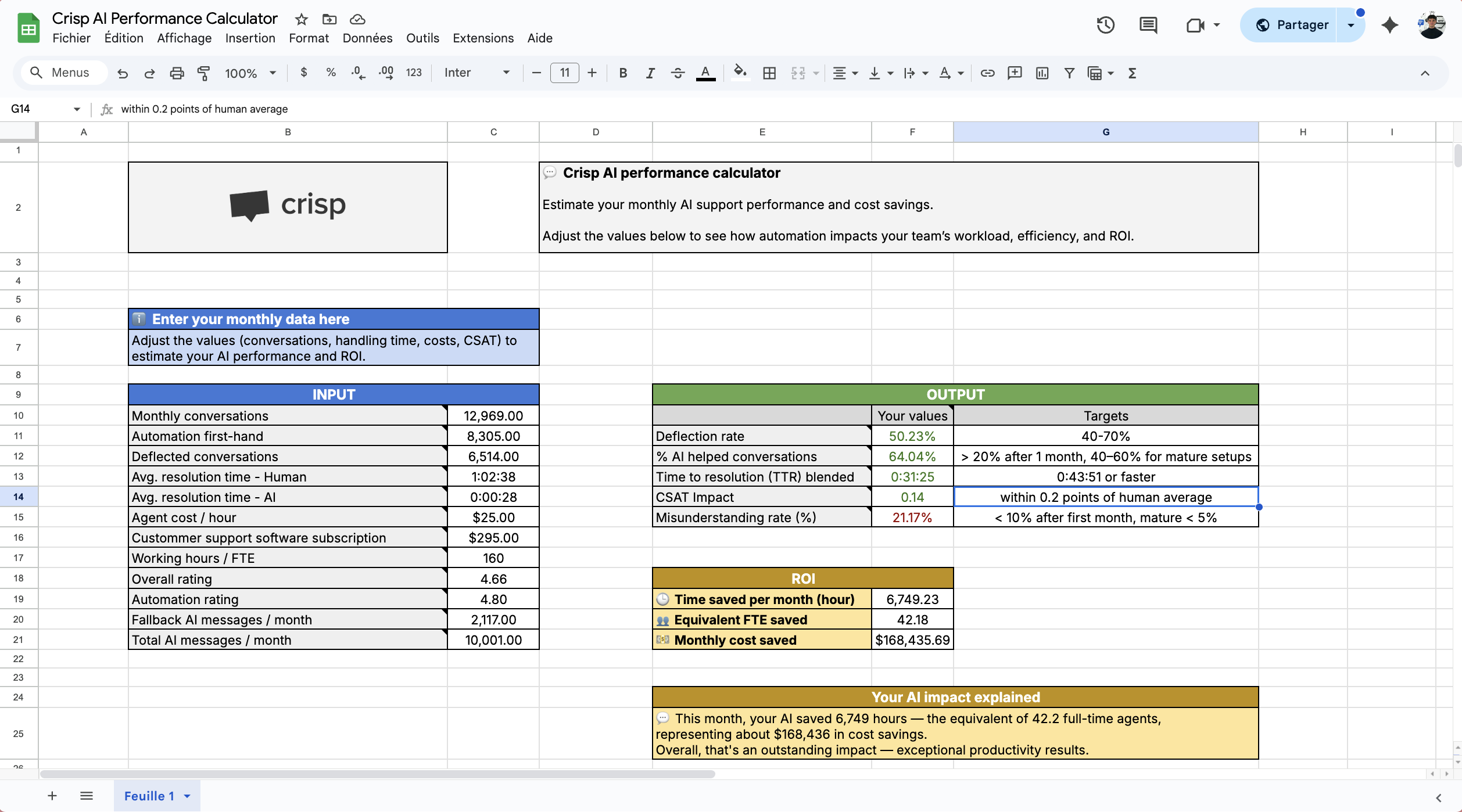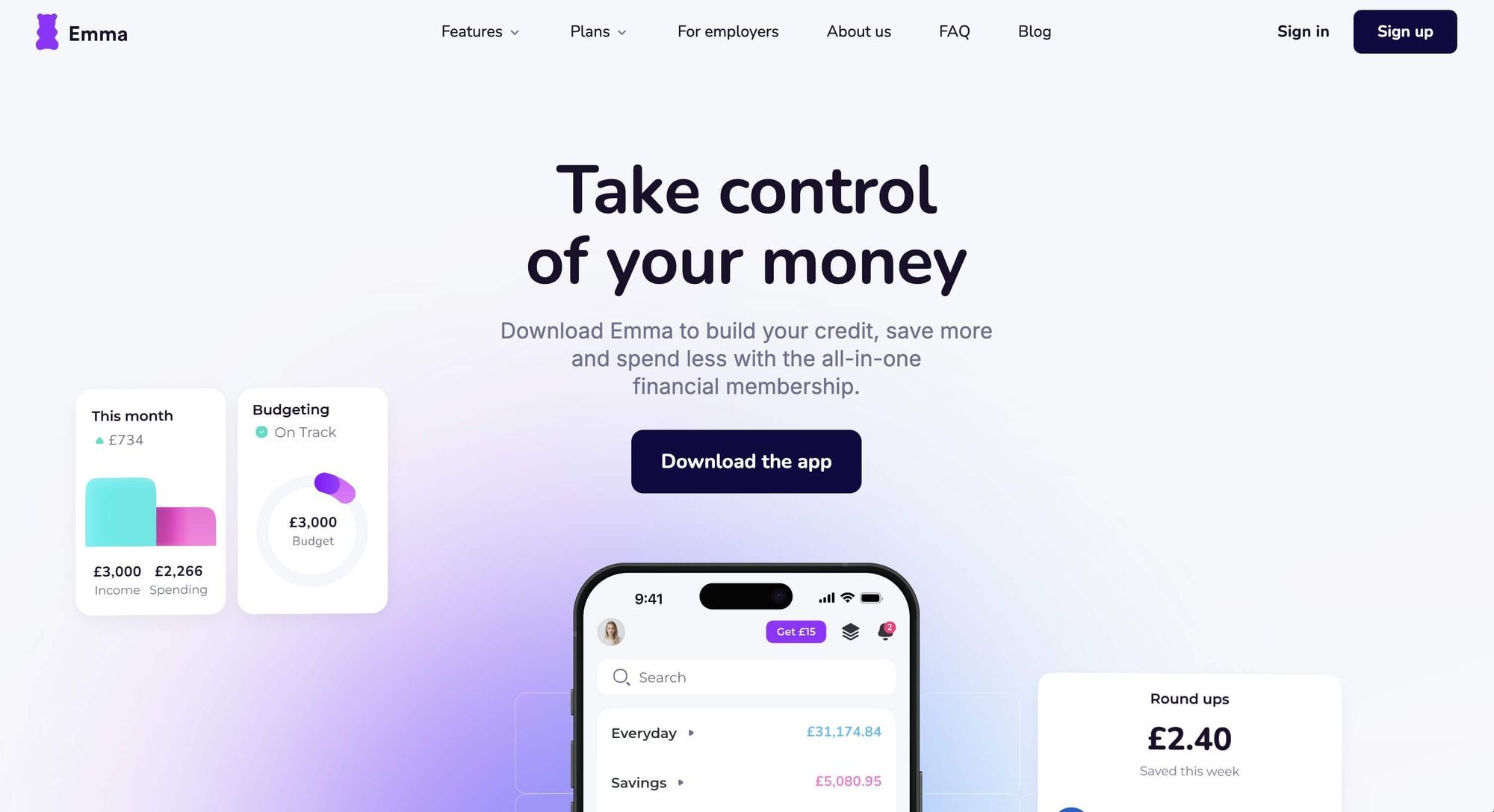Ticket deflection: How AI Chatbots reduce support backlogs
Drowning in support tickets? Discover how AI-powered ticket deflection helps teams cut workload, speed up responses, and keep customers happy, without hiring more agents. Learn how modern tools turn chaos into calm by solving problems before they ever reach your inbox.

This article is built and written from our webinar serie. It aims at helping companies scale their customer support through better AI-powered customer support workflows.
"Ticket deflection"
It might be a term you’ve never heard before, yet it’s quietly reshaping the way modern customer service teams operate.
With the rise of AI-powered customer support, it has become a critical KPI to track to measure AI's effectiveness and ROI.
One metric now sits at the center of efficiency discussions: ticket deflection. The rate at which customers find answers without ever creating a support ticket.
Why does it matter? Because in an era where every conversations can be automated, predicted, or personalized, the true return on AI investment is not how many tickets you resolve, it’s how many you never have to handle at all.
Ticket deflection captures that essence.
It turns the promise of automation into a measurable outcome, showing whether AI truly reduces support backlog, cuts costs, and improves the overall customer experience.
In this article, we’ll unpack what ticket deflection really means, how to measure it, and how AI-powered tools have made it one of the most important KPIs for modern support operations.
>>> Download the AI KPI Cheatsheet for tracking your AI ROI in your company
What is ticket deflection?
Ticket deflection refers to the process of helping customers resolve their issues without creating a support ticket. Instead of waiting in line for an agent, users find answers through self-service tools such as FAQs, AI chatbots, knowledge bases, search widgets, etc.
In essence, ticket deflection doesn’t mean “avoiding customers.” It means empowering them with immediate access to information so that only complex or high-value cases reach human support. This approach keeps the experience smooth for the customer while protecting teams from being flooded with repetitive queries.
Why does it matter for customer support teams?
Every incoming ticket adds to operational and mental load. High volumes stretch response times, increase costs, and raise burnout risks for agents.
For growing SaaS or e-commerce companies, this creates a vicious cycle:
- more users generate more requests, which requires more headcount to maintain service levels.
Effective ticket deflection breaks that cycle.
When customers can resolve their own issues, through contextual help or AI-powered assistants, support teams handle fewer conversations, response times drop, and satisfaction scores rise.
Ticket deflection rate and how to measure it
The ticket deflection rate measures how often customers solve problems without agent intervention.
A simple formula is:

Example:
If 800 users viewed help articles or interacted with your AI chatbot, and only 200 of them ended up creating a ticket:

Teams often pair this metric with first-contact resolution, CSAT, and average handle time to gauge efficiency holistically.
A high deflection rate, combined with strong satisfaction scores, indicates that automation and documentation are actually helping, not frustrating, users.
>>> Download the AI KPI Cheatsheet for tracking your AI ROI in your company
Traditional approaches: Knowledge management and queue management systems
Before AI entered the scene, companies relied on simpler methods to handle growing support demand.
Most strategies revolved around two ideas:
- help customers help themselves
- organize the line when they can’t.
That’s how knowledge bases and queue management systems became the backbone of traditional customer support.
Knowledge bases and help centers
For decades, companies have relied on static resources to deal with the rising volume of support inquiries:
- FAQ pages
- Documentations
- Community forums
When maintained well, these strategies work. They answer frequent questions instantly and give agents reliable reference material.
But static help centers have limits. Customers still need to know what to search for, and where to search. One of the most common mistakes companies make? Hiding help centers at the bottom of their website, or worse, not advertising it at all.
The deeper problem is that articles age fast. Ownership gets lost. And when a customer’s phrasing doesn’t match your keywords, the experience feels like hitting a dead end.
From static answers to managed queues
When self-service fails, customers escalate. That’s where queue management systems were born, first in the physical world, then online.
Originally built to control waiting lines in banks, hospitals, and government offices, these systems later evolved into digital versions that organize support tickets and assign priorities.
In principle, queue management brings structure and fairness. In practice, it often exposes wait times and amplifies frustration.
When a company’s main response to rising demand is to “manage the line” rather than reduce it, customers still feel trapped in the queue.
Limitations of legacy systems
Traditional ticket queues and static FAQs share the same flaw: they react instead of prevent. They’re built on the assumption that waiting is inevitable.
This mindset leads to long response times, inconsistent information, and disengaged agents. By the time a customer finally reaches someone, frustration has already peaked, and satisfaction scores drop.
Legacy queue systems treat the symptom, not the cause. And that’s where AI changes everything.
Instead of managing frustration after it happens, modern AI chatbots prevent it from happening at all. By understanding intent, context, and urgency in real time, they move support from reactive to predictive, transforming ticket deflection from a hopeful metric into a daily reality.
How AI tools are revolutionizing ticket deflection
AI tools have transformed ticket deflection from a passive strategy into an active force for efficiency. Where traditional systems waited for customers to reach out, modern AI leverage training data & company knowledge to improve the deflection strategy.
Understand questions, detect intent, and serve answers before a ticket is even created: this is not a dream anymore. The result? Faster resolutions, lighter support workloads, and a customer experience that finally feels effortless.
Because afterall, the best customer is the one that doesn't exist.
AI-Powered ticket deflection in action
Most people are thinking AI-powered resolution and deflection rates can only be powered through Chatbots. But this is wrong.
AI-powered search can also have impact on your deflection rate. Especially when you place it before any support experience.
Below, you can see a website that is empowering its customer support strategy with an AI-powered self-service support tool.

In that case, it has led to a decrease in 40% less support requests dealt by the support team.
Deflection beyond FAQs & Informative support requests
Modern AI goes far beyond scripted FAQ Chatbot. It doesn’t just answer questions, it takes action.
It can retrieve order details or account data securely, update customer information, or even trigger workflows directly inside your business tools.
Through Model Context Protocol (MCPs), AI can now connect with external systems: payment gateways, CRMs, delivery APIs, internal backoffice dashboards, to execute real tasks: refund a payment, check stock, cancel an order, or flag a suspicious transaction.
It also acts proactively, detecting recurring issues like shipping delays or login failures and launching automated responses at scale.
Instead of waiting for hundreds of identical tickets, AI resolves the cause before the first one arrives.
End of the support queue
When AI resolves simple queries instantly, the traditional concept of a queue becomes unnecessary.
There’s no “next in line” if the majority of issues never enter the line at all.
This shift transforms support from reactive firefighting into continuous assistance—always available, always on.
>>> Download the AI KPI Cheatsheet for tracking your AI ROI in your company
How to measure ticket deflection inside Crisp
Measuring ticket deflection isn’t just a reporting exercise, it’s how you turn AI performance into a real, measurable business outcome.
With Crisp Analytics and the ROI Calculator, you can understand exactly how many conversations your AI prevents, how much time it saves, and where you can improve.
Here’s a simple, step-by-step way to measure deflection, resolution quality, and overall AI ROI in your support workflows.
Import your AI analytics dashboard (JSON template)
Crisp provides a ready-to-use Analytics dashboard that surfaces every metric you need to understand your deflection performance — without building anything from scratch.
How to import it:
- Go to Analytics → Dashboards → Create new dashboard
- Click Import
- Upload the
.jsontemplate provided by Crisp
The dashboard appears instantly with all your AI KPIs structured and calculated

This gives you a full view of your AI’s performance: deflection rate, fallback rate, AI-resolved conversations, misunderstanding patterns, and time saved.
📥 Download the Analytics Dashboard (.json)
Understand the key metrics that drive deflection
Once the dashboard is imported, you’ll see a set of cards designed specifically to measure AI impact.
Here’s how to interpret them, in the simplest way possible:
• Deflected conversations
The number of conversations fully resolved by AI, with no human involvement.
• AI first-hand conversations
Conversations where AI handled the customer before any agent.
A strong leading indicator of automation maturity.
• Fallback messages
Times where AI didn’t understand or escalated.
A high number means training or documentation needs improvement.
• AI resolution time vs human resolution time
AI typically resolves in seconds; humans take minutes.
This delta directly impacts your operational cost.
• Automation rating / CSAT for AI
Shows whether customers actually like automated help — a key indicator of quality, not just quantity.
Together, these metrics tell you how well your AI is deflecting tickets, where it confuses customers, where your knowledge base is weak and how much load your agents don’t have to absorb.
Connect your metrics to the ROI Calculator
This is where the magic happens, where your deflection rate becomes real savings.
Open the Crisp ROI Calculator and fill in the blue Input section with the numbers from your Analytics dashboard:
• Total conversations
• AI-resolved conversations
• Fallback rate
• Average human handling time
• Average cost per ticket
• Resolution time (AI vs human)
The calculator automatically generates your ROI outputs:
• Deflection rate — % of issues resolved without an agent
• Time saved per month — total hours absorbed by AI
• Equivalent FTE saved — how many full-time agents that represents
• Cost saved per month — your financial ROI
• Misunderstanding rate — % of responses AI got wrong

This is the most accurate way to understand whether AI is reducing backlog, improving efficiency, and lowering operational costs.
📊 Use the ROI Calculator (Google Sheet)
Prefer a visual walkthrough? Watch the full tutorial
In this video, I guide you step-by-step through the entire method:
4 benefits of a good ticket deflection strategy with AI chatbots
When done right, ticket deflection doesn’t just lighten your inbox, it reshapes how your entire support team operates. AI chatbots for customer support turn what used to be a reactive function into a proactive system that scales effortlessly with your customer base. The impact shows up everywhere: fewer tickets, lower operational costs, happier customers, and more motivated agents.
Reduced support backlogs
AI-driven deflection filters out repetitive questions before they hit the queue. Instead of waking up to hundreds of “Where’s my order?” or “How do I reset my password?” messages, support teams see a cleaner inbox focused on complex or high-value cases.
This becomes especially critical during product launches, global outages, marketing campaigns, or seasonal peaks, when ticket volume can surge overnight.
AI absorbs the shock by resolving common issues instantly, keeping operations stable without requiring extra headcount.
Measure and lower support costs
Tier-1 inquiries — password resets, tracking questions, billing clarifications — often represent 50–80% of total ticket volume. Automating these interactions has an immediate, measurable impact on your bottom line.
Every resolved request means one less human-touch ticket, and the cost-per-ticket metric drops dramatically without affecting customer satisfaction. Over time, this compounds into thousands of dollars saved per month, while your human agents stay focused on the cases that actually require empathy or reasoning.
Then, measure deflection not just by volume but by total cost avoided. This gives you a real ROI-based deflection rate, the KPI that impresses both finance and operations teams.
Improved customer support experience
When customers get instant, relevant answers, satisfaction scores climb naturally.
AI chatbots keep tone, phrasing, and information consistent, so every user, no matter when they reach out, receives the same high-quality guidance.
And when escalation is needed, the full conversation context carries forward, preventing the dreaded “Can you explain that again?” moment that kills trust. The result: faster resolutions, fewer follow-ups, and a perception of always-on reliability that builds long-term loyalty.
Higher agent productivity
When AI clears the noise, agents log in to an inbox filled with meaningful conversations. This shift transforms the nature of the job: fewer repetitive tasks, more problem-solving.
Agents stay engaged, burnout drops, and the quality of human interactions improves because they have the time to think, not just react. Even onboarding becomes easier: new hires ramp faster when routine questions are already handled by automation.
How to implement ticket deflection successfully
Effective ticket deflection isn’t a one-click setup. It’s a continuous cycle of learning, training, and refinement, where human expertise and AI evolve together. Below are the four foundations that separate companies who experiment with automation from those who truly master it.
Build a strong knowledge base
AI can’t invent good answers; it can only surface what you’ve already taught it.
A reliable knowledge base is the backbone of every successful deflection strategy. Keep documentation current, structured, and written in natural, conversational language.
The goal isn’t just accuracy — it’s readability. Every resolved ticket is an opportunity to capture new knowledge. Turn common replies into short, searchable articles. Over time, you’ll build a self-reinforcing loop between human insight and automated intelligence.
Train your AI Chatbot with real content
The best chatbots don’t rely on perfect documentation; they learn from messy reality. Feed your system with data straight from the front lines: FAQs, help-desk transcripts, CRM notes, and tagged conversations. Include variations in phrasing, and tones.
Use topic tags and product categories to structure training data. This helps the AI recognize intent faster and give more contextually relevant answers, especially for multi-product or multi-region companies.
Monitor and continuously improve your deflection rate
Automation isn’t “set it and forget it.” To measure true impact, combine quantitative and qualitative metrics:
Deflection rate – percentage of customers who solved their issue without opening a ticket
CSAT for self-service – whether customers enjoyed automated help
Escalation ratio – how often conversations still require a human
Resolution accuracy – how many AI answers were correct or helpful
Review misclassified or escalated conversations weekly. Each one reveals gaps in content or training. The faster those loops close, the faster your deflection rate grows.
Combine AI with human escalation
Even the smartest automation needs a safety net. Define clear triggers for handoff:
- signs of frustration,
- repeated fallback answers
- explicit requests for human help
A well-timed escalation isn’t a failure of AI; it’s a sign of maturity. It ensures customers never feel trapped behind a bot, while agents receive full conversation context to pick up seamlessly.
The ultimate goal isn’t to hide your team behind automation but to let humans shine where empathy, creativity, or negotiation make the difference.
>>> Download the AI KPI Cheatsheet for tracking your AI ROI in your company
Crisp’s Approach to Ticket Deflection
Unified Inbox + AI Agent
Suggest content that explains the value of combining Crisp AI Chatbot + Crisp Shared Inbox
Building a custom dashboard that shows AI Chatbot's ROI for customer support teams
Craft a video that shows how you combine your custom dashboard (explain the concept, show how it works) with the calculation and measurement of ticket deflection
How Emma App turned AI into real ROI with Crisp
B2C support teams today face rising workloads: more channels, more conversations, and fewer people to handle them. Emma App decided to fight back, not with more hires, but with an AI-powered deflection strategy that paid off from day one.
The challenge: A small team, a growing user base, and no week-end support.

Emma is a fast-growing fintech helping users manage their money across the UK, US, and Canada.
With only five people in the support team, every weekend felt like a storm waiting to hit on the following monday. Either in terms of mental overload, or bad reviews on app stores.
“We wanted to serve users 24/7… but we were only five people.”
— Geoffrey Safar, Head of Operations at Emma
Every Monday started with:
- A backlog of unresolved tickets
- Poor App Store reviews from unanswered weekend messages
- A team on the edge of burnout
Something had to change!
The solution: Implementing Crisp AI Chatbot in their mobile app and website
Emma deployed the Crisp AI Chatbot, training the AI onto:
- Helpdesk and FAQ content
- Internal workflows for payment disputes
- Custom knowledge base and automation rules
Thanks to Crisp Mobile SDKs, they were able to automate conversation either on the mobile app and on the web version of the finance app for consumers.
Resulting in Crisp AI now handling :
- All weekend and overnight conversations automatically.
- Detecting customer intent and routing urgent issues.
- Resolves payment disputes without agent intervention.
The results: From overwhelmed backlog to balanced customer support
- ⏱ 3× faster resolution time on average
- 💬 100% of conversations handled over the weekend
- 📈 127% increase in conversation volume (from 3,500 → 7,200 per month), with zero new hires.
- 💸 Thousands saved each month through automated dispute workflows.
- 😌 No more Monday overload for the support team.
“It’s not about replacing support. It’s about keeping customers cared for — even when no one’s online.”
— Geoffrey Safar, Head of Operations at Emma
>>> Download the AI KPI Cheatsheet for tracking your AI ROI in your company
The takeaway
AI didn’t replace Emma’s support. It amplified it, turning stress into structure, and chaos into calm.
That’s what real ROI from AI looks like. Not hype. Just hours saved, customers happier, and teams breathing again.
FAQs on ticket deflection
What is ticket deflection in customer support?
It’s the process of resolving customer issues before a support inquiry is created, usually through AI chatbots, FAQs, search widget or help-center articles.
Is ticket deflection the same as self-service?
They overlap. Self-service describes the tools; ticket deflection describes the outcome: fewer tickets reaching agents.
Does ticket deflection reduce customer satisfaction?
When implemented transparently, it improves satisfaction by offering instant help. Frustration arises only when automation blocks access to humans.
What’s the difference between ticket deflection and queue management?
Queue management organizes waiting. Ticket deflection removes the need to wait altogether by resolving issues upfront.
Key Takeaways
Imagine a future where customer support feels less like waiting in line and more like having a personal assistant who already knows what you need.
No hold music. No “we’ll get back to you soon.” Just instant, contextual help — available anywhere, anytime, across every channel.
That’s where AI-driven ticket deflection is leading us. It’s not about dodging customers; it’s about building a world where support happens before frustration ever begins.
Ticket deflection is about preventing unnecessary volume, not ignoring your users. Every automated answer frees time for humans to focus on complex, emotional, or high-stakes cases.
AI chatbots and agents outperform static FAQs and outdated ticket systems by offering real-time, contextual help that feels personal, even at scale.
The magic lies in balance: automation for speed, accurate documentation for trust, and human escalation for empathy. Together, they create support experiences that are faster, cheaper, and genuinely satisfying.
In the end, the best customer support won’t be the one that responds fastest, it will be the one that rarely needs to respond at all.









